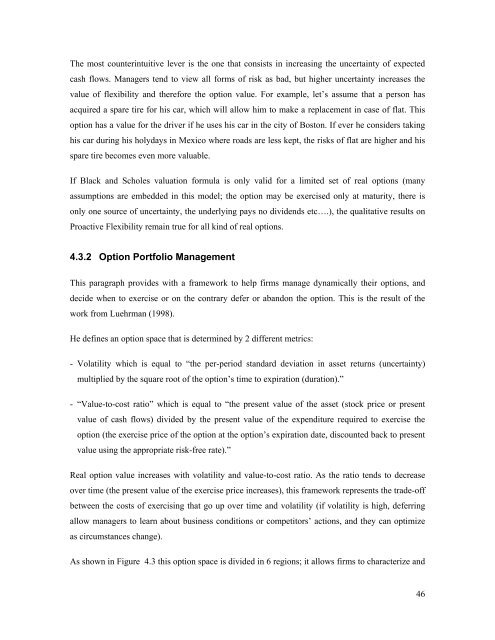Managing Risks of Supply-Chain Disruptions: Dual ... - CiteSeerX
Managing Risks of Supply-Chain Disruptions: Dual ... - CiteSeerX
Managing Risks of Supply-Chain Disruptions: Dual ... - CiteSeerX
Create successful ePaper yourself
Turn your PDF publications into a flip-book with our unique Google optimized e-Paper software.
The most counterintuitive lever is the one that consists in increasing the uncertainty <strong>of</strong> expectedcash flows. Managers tend to view all forms <strong>of</strong> risk as bad, but higher uncertainty increases thevalue <strong>of</strong> flexibility and therefore the option value. For example, let’s assume that a person hasacquired a spare tire for his car, which will allow him to make a replacement in case <strong>of</strong> flat. Thisoption has a value for the driver if he uses his car in the city <strong>of</strong> Boston. If ever he considers takinghis car during his holydays in Mexico where roads are less kept, the risks <strong>of</strong> flat are higher and hisspare tire becomes even more valuable.If Black and Scholes valuation formula is only valid for a limited set <strong>of</strong> real options (manyassumptions are embedded in this model; the option may be exercised only at maturity, there isonly one source <strong>of</strong> uncertainty, the underlying pays no dividends etc….), the qualitative results onProactive Flexibility remain true for all kind <strong>of</strong> real options.4.3.2 Option Portfolio ManagementThis paragraph provides with a framework to help firms manage dynamically their options, anddecide when to exercise or on the contrary defer or abandon the option. This is the result <strong>of</strong> thework from Luehrman (1998).He defines an option space that is determined by 2 different metrics:- Volatility which is equal to “the per-period standard deviation in asset returns (uncertainty)multiplied by the square root <strong>of</strong> the option’s time to expiration (duration).”- “Value-to-cost ratio” which is equal to “the present value <strong>of</strong> the asset (stock price or presentvalue <strong>of</strong> cash flows) divided by the present value <strong>of</strong> the expenditure required to exercise theoption (the exercise price <strong>of</strong> the option at the option’s expiration date, discounted back to presentvalue using the appropriate risk-free rate).”Real option value increases with volatility and value-to-cost ratio. As the ratio tends to decreaseover time (the present value <strong>of</strong> the exercise price increases), this framework represents the trade-<strong>of</strong>fbetween the costs <strong>of</strong> exercising that go up over time and volatility (if volatility is high, deferringallow managers to learn about business conditions or competitors’ actions, and they can optimizeas circumstances change).As shown in Figure 4.3 this option space is divided in 6 regions; it allows firms to characterize and46
















